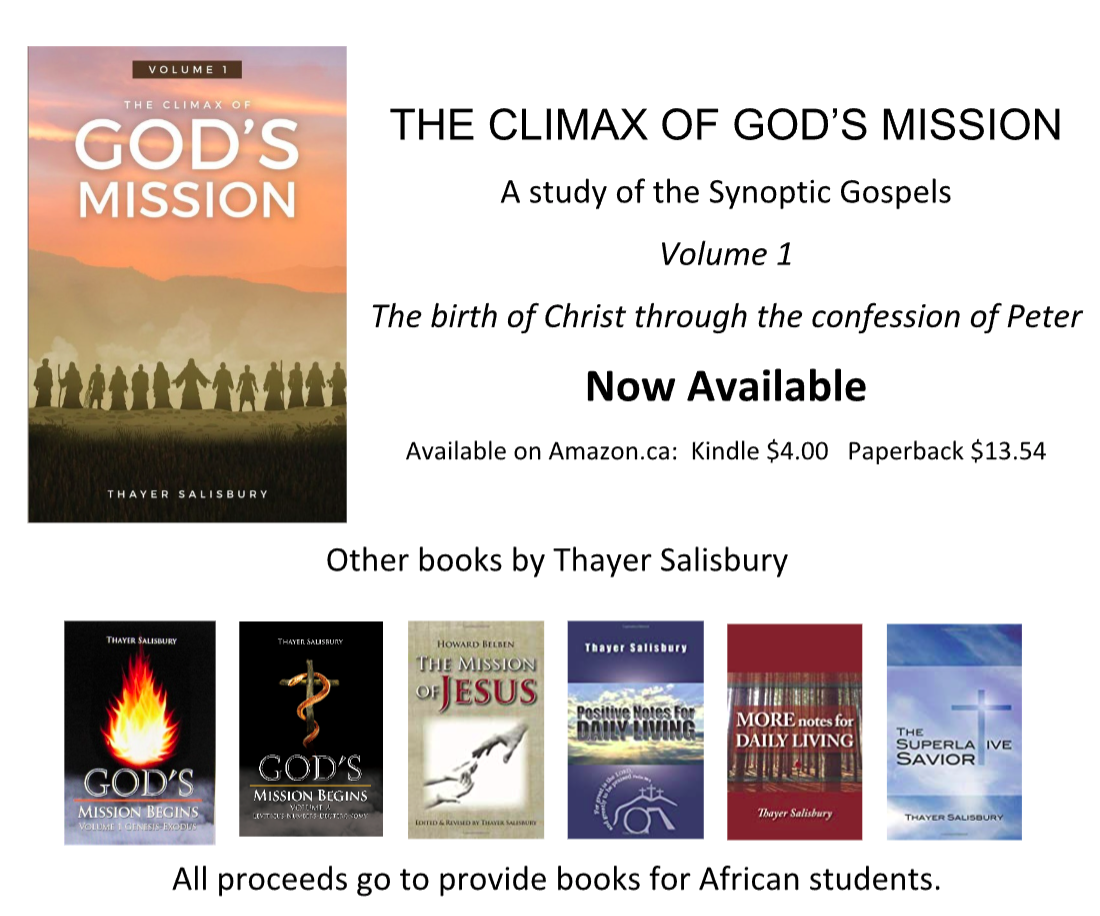Wrap-up
In our Introduction, we asked several questions:
- How did the general Christian religious landscape of today develop?
- How did religion influence history in the areas that were nominally Christian?
- What can we learn from the various developments?
- Can we see the hand of God working through time?
- Can we look our own time and practices through a broader lens than we have used?
In very brief summary, our History has looked at:
2nd and 3rd centuries – Primitive Christianity:
- The state of the Christian churches as the apostolic age ended.
- Christianity as an illegal religion in the Roman empire.
- Periodic persecution
- The Church Fathers:
- Early writers. Not inspired, and often proposing non-Biblical concepts.
- However, also showing early church practices which give insights into how the early church operated.
- The formulation of the New Testament canon.
- Though most books were generally accepted from the beginning, until agreement in the 4th Century there was no way to appeal to Scripture and have all agree that it was Scripture.
- By that time, much church practice and teaching had developed apart from Scripture, and had become embedded in the church.
- The Unity of Christianity:
- Ongoing attempts to define correct doctrine – often as a result of having to refute bad doctrine, or heresies.
- Various heretical teachings:
- Docetism – Jesus only seemed to be a man.
- Gnosticism – the idea that people could be saved through a secret knowledge, not contained in Scripture.
- Integration of Greek philosophy with Christian teachings – for example, leading to the idea that the material creation is evil, and only Spirit was true and real.
- Marcionism – anti-Jewish Christianity – rejecting the OT and most of the NT, the idea that the God of the OT is different than the God of the NT.
- Montanism – that ongoing Holy Spirit revelation continued.
- Novationism – refusing to re-admit any who had renounced Christ under persecution.
- General concept that baptism could cover only sins already committed, that many offences such as idolatry after baptism were unforgiveable.
- Development of the Roman church.
- Spread of early Christianity was primarily Urban – not a lot of penetration to the countryside.
- Changes in church polity – as the church grew in an area, there would be multiple congregations – the bishops came to oversee all those churches, rather than being for a specific congregation.
- Development of ‘main’ Christian centres – Jerusalem, Carthage, Alexandria, Rome, Antioch, and Constantinople (after 300AD.)
- Beginning of veneration of martyrs and saints:
- Aided by incoming former pagans, who equated the saints with their old gods.
4th through 6th centuries – Christianity as Roman State Church:
- Christianity legalized (313AD) under Constantine.
- Christianity becomes the Roman state religion (380AD) under Theodosius with the Edict of Milan.
- Struggle between Religious and Secular leaders for supremacy starts (and lasts for 1500 years.)
- Heresies:
- Arianism – that Jesus was a created being, not co-existent and co-eternal with God.
- Donatism – similar to Novationism, except held that any church that readmitted repentant Christians who had denounced Christ were apostate churches – polluted – including the Orthodox church.
- Orthodox Church teachings that varied from the New Testament:
- Original sin.
- Infant baptism replacing believers’ baptism.
- Communion became viewed as a re-offering of Christ’s sacrifice on the cross, rather than a sacrifice of praise and thanksgiving.
- Clergy was to be celibate (elevation of asceticism to mean ‘real Christianity’.)
- Beginning of general church (Ecumenical) councils to decide matters of doctrine and church practice:
- Formulation of Nicene creed.
- Expansion of Christianity into much of the Roman countryside.
- Increase of the power of the Bishop of Rome – developing into the Papacy:
- Concept of Apostolic Succession.
- Latin translation of the Bible, the Vulgate (405AD.)
- Fall of the Western Roman Empire around 476AD, and the Catholic Church being just about the only institution to survive that fall.
- The rise of monasticism – withdrawal from the world and it’s sinfulness to dedicate oneself fully to God.
7th through 16th centuries – The Middle Ages
- The Pope starts assuming secular powers as well as Spiritual – e.g. dealing with invaders in Italy.
- Founding and rise of Islam, and the taking of Palestine, North Africa, and Spain. Leaving only Rome and Constantinople of the important Christian centres.
- Sequence of decline and renewal of Christianity in Europe.
- Holy Roman Empire – partial attempt to revive the Western Roman Empire:
- Continued jockeying for power between Secular and Religious leaders – who is supreme?
- Eastern Orthodox church – correct belief becoming more important than correct behaviour:
- Struggle over Monophysitism – the believe that Jesus’ humanity was swallowed by his divinity, as opposed to Jesus being both fully human and fully God.
- Struggle over iconography – what objects are sufficiently ‘holy’ so as to deserve worship?
- Conflict between Roman and Orthodox churches:
- Final split of Western and Eastern churches in 1054AD.
- Moscow becoming the centre of Eastern Orthodoxy following fall of Constantinople in 1453 (Third Rome.)
- Struggle over who could appoint the pope – clergy or lay people?
- Transubstantiation formalized in 1215.
- Seven sacraments: Baptism, Confirmation, Eucharist, Penance or Confession, Extreme Unction (now called Anointing of the Sick), Ordination, and Matrimony.
- Continued development of Monasticism – orders such as Benedictine, Franciscan, Dominican, all orders owing their status (and thus their allegiance) to the pope.
- Most education in Europe was handled by the church.
- Rising of interest in Greek and Latin to access the ‘old wisdom’ – Greek Philosophy, for example:
- Rise of Scholasticism – idea that answers were to be found in these old works.
- Attempt to harmonize Christianity and Greek Philosophy – e.g. Thomas Aquinas.
- Foundation of modern science in the 13th century – understanding that observation, experimentation, and measurement were critical in better understanding the world around us.
- Church buildings became large and ornate – cathedrals, Romanesque and Gothic – Notre Dame in Paris, Hagia Sofia in Constantinople.
- Incorporation of statues, stained glass into churches – to help the lay people come to a better understanding of Christianity.
- The Crusades – attempt to retake the Holy Land for Christianity.
- Europe as a ‘Christian Community’ – foundational for all of life. No separation between ‘religious’ and ‘non-religious’ activities as is common today.
- Persecution and Inquisition against ‘heretic’ Christians.
- Multiple popes.
1400-1650 – The Reformation
- Background to the Reformation:
- Corrupt Catholic Church.
- Non-church threats to Europe: Bubonic plague, Muslim threat.
- New lands, new nations – world exploration.
- Renaissance (literally re-birth):
- Reviving of classical Greek and Roman civilizations in the arts, politics, and world-views.
- Education becoming more widely available.
- Printing Press.
- Spiritual renewal in the Catholic Church: “The Modern Way of Serving God.”
- Martin Luther’s 95 Theses against indulgences, 1517:
- Criticized this Catholic practice as not warranted by Scripture, Tradition, or Reason.
- Rise of Protestantism, on these main principles:
- God’s Word of authority.
- By grace alone.
- Every believer a priest.
- Spread throughout Europe, though in varying ‘flavours’, leading to many Protestant denominations:
- Led to, or contributed to, religious based or influenced wars over the next 150 or so years.
- Proliferation of Bible translations.
- Anabaptists: characterized by:
- Discipleship – life must change.
- Love – including pacifism.
- Restoring the NT church – a family in Christ, through God’s working, based on authority of Scripture.
- Separation of church and state – faith is free gift of God, not enforced by secular authorities.
- Baptists – early 1600’s.
- Catholic Reformation / Counter Reformation:
- Reform of papacy, founding of the Jesuits, abolishing of indulgences (what Luther protested about!)
- One result of the Reformation was that Europe was no longer a basically single society with religious unity.
1650-1789 – Reason, Revival, and Revolution
- Spread of Christianity in North America in the 1600’s – many oppressed religious groups made their way to the Americas.
- Great Awakening: 1740’s America, Germany, England, Scotland:
- Nominal Christians became committed, Evangelism spread, pastoral care improved.
- Rise of the ‘Societies’ to promote Christian work.
- John Wesley and Methodism – England and America.
- Hymns and Church Music – Metric Psalms, new ‘man-made’ hymns.
- The Russian church – the third Rome:
- Centre of Orthodoxy in the east, state Church.
- Rise of Missionary societies, and Catholic missions. Christianity reaching around the world for the first time:
- Wrestled with the relationship between Christianity and indigenous culture.
- Recognized the importance of local Christian leaders.
- Importance of translating the Bible.
- Reason and Unreason:
- Rationalism – belief in the rationality of the universe – Descartes, Spinoza, Leibniz.
- Empiricism – stressing the part played by experience in knowledge – Locke, Berkely, Hume.
- Does God exist? Is there any reasonable foundation for believing in God?
- Deism – attempt to demonstrate rational belief in God, without using the special revelation of the Bible.
- Christian Apologists:
- Showing the Bible authors were reliable and honest.
- Using the evidence of miracles to show that Bible belief was reasonable.
- Showing is was false to suppose that God always behaves according to strict human rationality.
- Showing that reason justifies only probable inferences about the world – and so both natural and revealed religion can be accepted on the same grounds as from the same author.
- Quakers.
1789-1914 – Cities and Empires
- Industrial Revolution – population shifts from rural to urban:
- In England, Methodism grows as many new urban workers are drawn to it.
- Start of Salvation Army.
- French Revolution – in part based on new concepts on society, questioning the ‘divine right’ of monarchs:
- Early state based on secular principles rather than religious principles.
- 1840’s – Revolutions in France, Germany, Italy.
- Decrease of Pope’s political power in the 19th century.
- Greater awareness of the question of a Christian’s citizenship in this world and in the next:
- Is earth ‘enemy country’? Or should Christians intentionally work to influence society?
- Latter led to opposition to slavery, eventual abolishment, for example.
- Wilberforce’s A Practical View of the Prevailing Religious System of Professed Christians in the Higher and Middle Classes in this Country contrasted with real Christianity had a huge impact on society in Britain.
- Ongoing cycles of religious stagnation, then revival.
- Worldwide vision – Missionary Societies become popular, most being cross-denominational.
- Further development in style and content of Hymns and Church music:
- Music for each season of the Christian year.
- Publication of hymnals exploded.
- Slavery in America – civil war 1860’s:
- End of the war saw slavery abolished.
- However, prejudice remained (and still remains.)
- Churches had split over the issue, and didn’t reconcile.
- Rationalism and Skepticism in the 19th Century:
- Science, Philosophy, History used to try to show Christianity had no leg to stand on.
- Idea that the earth is ancient, and gradually became what it is today – i.e. no sudden ‘Creation.’
- Theory of Evolution, Origin of Species.
- Kant, Nietzsche, Kierkegaard.
- The Bible under fire – both Old Testament, and the figure of Christ.
- Reconstruction of original Greek NT was substantially completed:
- Studies of other Greek documents showed by style and word analysis that NT documents had been written by the end of the first century.
- Missionary Society results during this span spread Christianity all around the world:
- By 1914 the vision was the ultimate evangelization of the world within their lifetimes.
- Missionary bravery, dedication.
1914-Present
- Height of Imperialism:
- Estimated that 90% of the world’s surface was controlled by 10 imperial powers:
- Britain, France, Italy, Germany, Russia, Japan, Netherlands, Spain, Portugal, USA.
- Adding in China and Ottoman empires brings this close to 100% of the world’s land area controlled by 12 empires.
- Estimated that 90% of the world’s surface was controlled by 10 imperial powers:
- Development of Ideologies:
- Totalitarianism – Left Wing: Communism, Socialism Right Wing: Fascism.
- Nationalism and Individualism.
- Not religions, but world views that took on a number of characteristics of religious faiths.
- World views that affect behaviour, thinking patterns, expectations, and often vehemently opposed differing thought patterns or outlooks.
- WWI – First ‘total war’ – globally, and impact on civilian populations:
- Imperialism was a prime cause as various countries vied for real estate – which substantially could only come from other country’s colonies.
- Was often viewed as a ‘righteous’ war.
- Appearance of left-wing (Liberal) parties – e.g. Social Democrats in Germany, which became the Nazi party.
- Christianity’s reaction to, and under, totalitarianism:
- Most totalitarian states were either anti-Christian (e.g. Germany) or just used Christianity (e.g. Russia and Marx’s “Religion is the opium of the people”) to help maintain control.
- Pope compromising with Mussolini in Italy, in part being completely anti-Communist.
- Oppression and persecution of Christians was often the situation.
- Many stood up – and were arrested or put to death.
- WWII – in a sense a continuation of WWI after a 20 year truce:
- Many of the situations at the close of WWI had not been resolved.
- Germany and Italy were becoming Imperialist nations, bringing them into conflict with existing Imperial powers.
- Expanded war even further as far as impact on civilians – bombing of cities, for example.
- Post-WWII:
- End of the Fascist and Socialist states, but not of Communism.
- Developed into an east – west polarization.
- Often made its way into churches – especially in the USA – as society was vehemently anti-Communist.
- Lessons about Christianity and Totalitarianism:
- The dangers of compromise – seemed right at the time (e.g. to be able to continue to have churches operate), but in hindsight often led to consequences that substantially harmed the Christian churches.
- Merging societal views into Christianity is not a good thing.
- Shameful history of the Christian Church and its view and persecution of Jews since the second century.
- Racial tensions with religious overtones – e.g. relations between black and white, and effects on churches.
- Civil Religion – blending civil symbols and ideas with Christianity, often something secular becomes effectively sacred, and helps support the state and allegiance – hyper patriotism, for example.
- Liberal Theology – replacing the literal understanding of the Bible with a figurative, in an attempt to make Christianity more palatable to a broader range of ‘modern’ peoples.
- For example, Jesus didn’t really rise from the dead – what is important is the renewal of His spirit in His followers. Or, that the feeding of the 5,000 wasn’t a miracle – the little boy who shared his lunch shamed the others into sharing food they already had but weren’t willing to share.
- Rise of Fundamentalism against Liberal Theology:
- Charge that these ‘modernists’ were compromising Christianity to the point it wasn’t actually Christianity any more.
- Held to five ‘Fundamental’ points that needed to be maintained.
- The Bible is the Word of God, given by and inspired by Him.
- Jesus was born of a virgin.
- Christ actually performed supernatural miracles.
- Physical resurrection of Christ.
- Christ will return personally, there will be a real second coming of Christ.
- All of these maintain what the Bible actually teaches. Not some ultra-right wing Conservative effort the way the term Fundamentalist tends to be used today.
- Increased questioning of Jesus: History of Faith?
- Positivism and Christianity – the idea that all valid knowledge comes through, and only through, science.
- Existentialism – Individuals are free and responsible agents in determining their own development.
- Sometimes anti-Christian, sometimes pro-Christian.
- Cheap Grace – reaction against Christians who don’t live Christ.
- Linguistic Philosophy – realizing that translation is more than just word equivalences.
- Biblical Theology – reducing the scope of the Old and New Testaments to solely the record of God’s redeeming of humanity.
- How many theologies?
- Revolutionary Christians – bending Christianity to support of revolution.
- The Gospel for Africa and India.
- Changing Missions.
- Pentecostalism and the Charismatic Movement.
- Bible translation over the past 100 years.
- Ecumenicalism.
- Present and Future.
Summary:
- We owe quite a debt to the ancient church
- we are the inheritors of understandings that we sometimes take for granted, but took much work and sometime struggle to understand
- Doctrine of the Trinity – the godhead, existing eternally, three in one.
- Christology, the doctrine of Christ, god and Man. Jesus 100% God, 100% man.
- He had everything essential to being human, and everything essential to being God.
- He could not be a substitutionary sacrifice were He not human.
- But – only God can save.
- The NT Canon.
- The foundation of missions – the early church was a missionary church:
- The number of Christians in the world in 500AD is estimated to be about the same as the number in 1500AD.
- WHERE those Christians were shifted from all around the Mediterranean, to centered in Europe.
- Doctrine of the church.
- Doctrine of the sacraments – i.e. baptism and communion: not how they came to be viewed later.
- Doctrine of worship.
- Doctrine of ministry.
- Doctrine of salvation – what role does God play? What role does the person play?
- Similarities between the situation of the early church and today:
- Christians in the first centuries saw themselves as a small minority, facing a culture that was big, powerful, sophisticated, proud, and anti-Christian.
- Early Christians had a hard time convincing this world that they had something to say that Rome didn’t already know, that they had some insight into truth that the great Greek and Roman philosophers hadn’t already gained. “What’s old must be true.”
- For today – we often face “What’s new must be true.”
We can’t definitively trace the hand of God in specific events of movements, though we know God is sovereign. We do see that Jesus has built his church, and the gates of Hades has not overcome it.
Questions: Wrapup
- What has stood out for you from our study?
- Have you gained any insights that will be helpful for you in understanding Christianity?
- Are there aspects that you’re more aware of than previously? (e.g. the tendency to merge current culture into Christianity, rather than see how Christianity can work in current culture?)
- What would you say is the difference between the Gospel, and Theology?
Notes on the Class Notes for ‘History of Christianity’
Any sections completely in italics are my own observations / conclusions, and not taken from the source material.




Any quoted sections without attribution are taken from the primary text “Introduction to the History of Christianity”, referenced on page one of the first section of notes.
The notes are generally readable by anyone – but for one who wishes to lead a class, I strongly recommend extra readings and gathering of background information.
I taught this class as a Sunday morning adult class over the span of about 5 months, though there were numerous times when the class was preempted for other purposes. Generally, each section took about three weeks to cover. I skipped over some sections – making the notes available to the class (in advance) and recommending they read the skipped sections outside of class.
Suggested additional resources:
These are resources outside of those mentioned on page one of the first section of notes. I have experience with these – you may have others, or can find others.
Church Fathers
For example:
Early Christians Speak: Faith and Life in the First Three Centuries, Everett Ferguson, ACU Press, Third Edition, 1999
Early Christians Speak: Faith and Life in the First Three Centuries, Volume 2, Everett Ferguson, ACU Press, 2002
On-line Church History Classes
For example:
Church History, Ligonier Connect (by Ligonier Ministries, the teaching fellowship of R.C. Sproul – a Reformed / Calvinist minister, there are aspects of this that show up in the classes)
Bob Sandiford, September 2020

